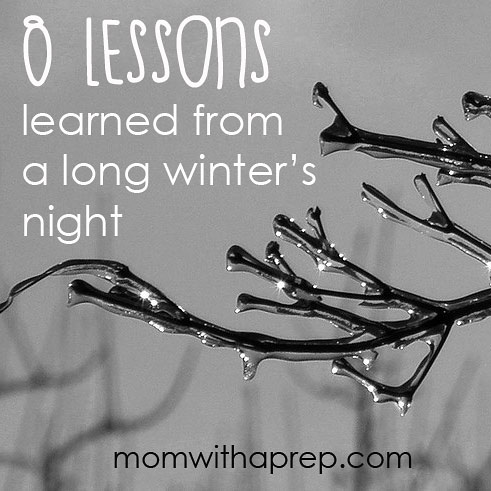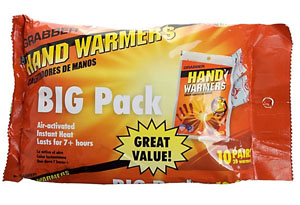We thought we were doing pretty well to prepare for the weather. We really thought we were. But we sure learned some lessons last night.

Living in Texas, you would assume that we have little to worry about for cold weather. Normally, I would agree. We get a few cold snaps that might have some snow and ice, for two days, and then we’re back to winter-lite weather. Those that live up in the panhandle of Texas get weather that’s more like what you get in the plains states, but down here for the rest of us, it’s not so harsh.
How’s Winter Weather in Texas?
So, we have 1 or 2 weather events a year, and generally, we’re over it in a few hours (but from the sheer amount of weather coverage, whining, and the sky is falling antics of the populace, you’d think we were in for the winter apocalypse (which I saw a friend of mine dub the ice ‘pockylips’ yesterday.).
However…there comes a time when the weather does turn a little nastier than usual. And then you find out you thought you were prepared, but you really weren’t.
I’ll be the first to admit we’re not ready for everything. That’s what we’re doing – learning, preparing, and getting ready, right along with you, and sharing it all here, truthfully. So truthfully, we weren’t prepared for our night last night when we lost power on one of the coldest nights on record.
8 Lessons about Being Prepared for the Winter Weather
1. Prepare for Losing Power
With downed power lines from trees that have not lost their leaves and are over-burdened with ice, from a power grid unable to handle the strain on a load and needs lots of hiccups to catch up. So be prepared for those things you’ll need to do to survive without your power.
Extra lights, blankets, batteries, alternative communication, power, etc. We don’t have backup power. In the summer, we can exist without it. In the winter? There are issues.
2. Prepare your Weather Radio
While you’re not trying to figure out where the next funnel cloud is going to touch down, it’s good to know where a storm system is heading when you no longer can get online or get a television signal.
3. Prepare Many Blankets for a Bad Winter
Blankets can be used to cover bushes and plants outside to help protect them, they can be used to cover your windshields to help protect from snow (though with ice, you probably want something more like plastic that won’t absorb all the moisture).
You can use them to cover up the children who keep throwing off all of their covers and sleeping on top of them, even when there is no heat. Having those extras to throw on top helps keep from waking children who are sleeping through the said “pockylips”.
Use blankets to cover drafty windows to help keep the heat in, or to close off open rooms. You can also use a blanket or 3 to throw over your freezer to help insulate it in case your power doesn’t come back on immediately. Granted, when it’s 21F in your garage, you probably don’t need that insulation, but it can only help, right?
4. Do NOT Bang the Ice on Your Car’s Windshield
Do NOT use a hammer or other hard object to bang away at the ice on your windshield, hoping to get to work on time. Just ask one of our neighbors. They have permanent air conditioning in their car now.
5. Use an Off-Grid Heat Source During Bad Winter Weather
During the day when you do have power, you can bake a lot to help keep the house warm if your house was not made for winter temps. But when there’s no power, how do you keep yourselves warm? If you have a fireplace, it can be helpful, but in a lot of suburban tract-housing, the fireplaces were built for show, not for actually USING, so they aren’t always effective ways to heat a room.
There are propane and kerosene heaters that can be used to heat smaller spaces to help keep you going. Invest in one. It might actually come in handy! I only wish we had already.
6. Use Affordable Hand Warmers During Winter Weather
Yeah, I thought only people sitting in football stands used them. But let me tell you, they really work! So go invest! Some online friends suggested that we use these like hot water bottles…turn them on and throw them into the bed with you to help keep your beds warm overnight (just don’t sleep right on top of them).
They also work well in your coat pockets if you’re at the football field in sub-freezing weather watching the high school playoffs.
7. Shut the Doors to Non-Essential Rooms
We’ve learned this from a relative’s house – if you keep the doors shut, the warm air can’t circulate well, and rooms tend to get colder if they are closed off from everyone else. However, if you don’t need that room, shutting doors can help keep the warmth where you need it most (you can even shut the vents in those rooms to help redirect that heat).
8. Do NOT Trim your Trees During Winter Weather
The weight of ice on trees can really drag them down. Even more so when the leaves haven’t fallen off the tree, yet. Limbs were created to be flexible, thus trees hanging low to the ground on an icy day is normal.
The blowback effect from trimming a tree that doesn’t need it can be harmful to you, and to your property. If your house is in danger of a cracking limb that is about to fall, you might want to see if you can get some help to limb it up before trying to tackle it, but don’t wait until this moment to try to clear your limbs and branches from above your car or from the house line.
You may cause more damage than you are trying to protect from. Again, ask the neighbor who was out trimming ice-laden branches and how has a sizable dent in their car from that said bounce-back effect. His car was fine before. And no, this isn’t the same neighbor who tried to use a hammer to get the ice off the car.
(This is also a great time to talk to you about what kinds of trees you plant. I get that you want to plant fast-growing trees to bring shade and value to your house. However, those fast-growing trees tend to be the weakest in terms of weather events – fastest to fall during high winds or winter weather. Really consider being a little more patient and pick trees that are safe.)
Your Last Tip about Being Prepared for Winter Weather
Finally, a bonus tip about winter weather: That UPS power thing your husband talked you into getting that will save you from losing all of your work when we get those fun power surges from the electric provider – it will beep ALL NIGHT LONG when the power goes on and off at your house. If you don’t need to hear that, you might want to unplug it before you go to bed.
Trust me. BUT…if you had been working on something, and if you’re set up where you will still have some wifi even if the power goes off in your house, it is an invaluable tool to have. (but if you have other means of communication and you’ve already saved your work, turning it off is a good idea 😉 )
There are other lessons that are invaluable…read about them here:
Don’t just “Fall Back”, get prepped for the winter! from The Survival Mom
Emergency Power Options for Your Home (great in a winter blackout) from Commonsense Homesteading
Are You Prepared for Winter? from Survival at Home
Our Preparedness Adventure from Your Preparedness Station
Hypothermia Symptoms and Treatments from Food Storage & Survival
Find other Winter Preparedness Tips on my Weather Pinterest Board.

Katy Willis is a writer, lifelong homesteader, and master herbalist, master gardener, and canine nutritionist. Katy is a preparedness expert and modern homesteader practicing everyday preparedness, sustainability, and a holistic lifestyle.
She knows how important it is to be prepared for whatever life throws at you, because you just never know what's coming. And preparedness helps you give your family the best chance to thrive in any situation.
Katy is passionate about living naturally, growing food, keeping livestock, foraging, and making and using herbal remedies. Katy is an experienced herbalist and a member of the CMA (Complementary Medical Association).
Her preparedness skills go beyond just being "ready", she's ready to survive the initial disaster, and thrive afterward, too. She grows 100% organic food on roughly 15 acres and raises goats, chickens, and ducks. She also lovingly tends her orchard, where she grows many different fruit trees. And, because she likes to know exactly what she's feeding her family, she's a seasoned from-scratch cook and gluten-free baker.
Katy teaches foraging and environmental education classes, too, including self-sufficient living, modern homesteading, seed saving, and organic vegetable gardening.
Katy helps others learn forgotten skills, including basic survival skills and self-reliance.
She's been published on sites such as MSN, Angi, Home Advisor, Family Handyman, Wealth of Geeks, Readers Digest, and more.

